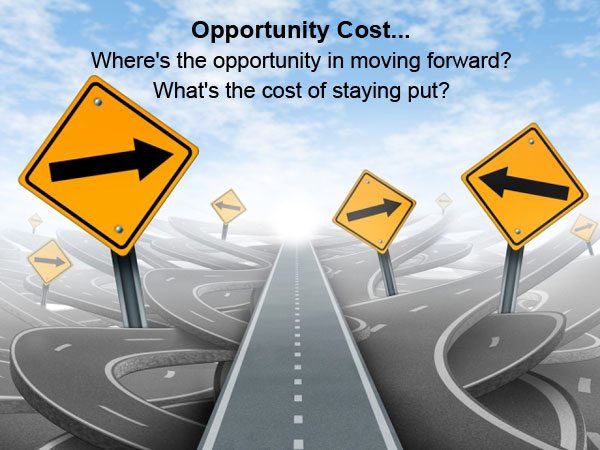Opportunity Costs: Leading Amidst a State of Flux
“It is not the strongest of the species that survive, nor the most intelligent, but the one most responsive to change.”
Charles Darwin (12 February 1809 – 19 April 1882) was an English naturalist and geologist, best known for his contributions to evolutionary theory.

Source: http://www.shutterstock.com
Amidst the fast-paced flux of our environment, we want to effectively lead our organization and teams to ensure our people don’t get left behind or are wedged in a perpetual state of inertia. But can leaders anticipate problems and/or respond equally to everything that is thrown our way?
The economic concept of “opportunity costs” comes into sight when thinking about leadership through the complexity that we all face. Economists tell us that opportunity costs are “the loss of potential gain from other alternatives when one alternative is chosen.” In other words, they are a “trade off” of one action or decision for another one that is deemed better.
Consider these questions when we think of opportunity costs in light of strategic, financial, operational, human capital or even personal decisions:
- What do I lose if I pursue one market over another? Will I be able to capture the share of the chosen market, growing my business or will I have left behind a potentially lucrative set of customers or clients?
- What happens when I close a plant or divest a business unit? Have I lost loyalty from employees and/or customers?
- I’ve hired an external candidate over an internal one to manage my human resources function – will my people follow him/her?

One thing is for sure – not responding is no longer an option. When it comes to leadership, what are the costs of inaction, delayed action or over-reaction? Leaders must assess, “what message am I sending my employees”:
Am I settling for mediocrity vs. greatness?
Am I spinning my wheels vs. creating forward momentum?
Am I afraid to take chances vs. willing to go out on a limb for something?
Am I responding to the squeaky wheel vs. what my organization really needs?
After you have evaluated these opportunity costs and made the decisions, it is time to lead. In my experience, I’ve found that some tried-and-true change leadership principles run true.
1. Commit to the direction and decisions made.
Make a personal commitment to move forward in the direction you’ve chosen. Say “yes” and reassure yourself that you’ve evaluated the potential costs of the alternatives, and the path you’ve chosen is the best for your organization and team.
2. Let go of foregone opportunities (for now).
Holding onto other opportunities can slow you down and misdirect you. This can be difficult, but saying “no” to other extraneous or tangential opportunities will set an example and send a message to your people. This doesn’t mean you will never consider alternative option(s) again. But to move forward, you need to let go of the excess weight.
3. Set the destination (vision and mission).
Now that you’ve committed, you must paint the picture of what the future looks like for your organization or team. Be clear, precise and definitive in where you want your people to go.
4. Chart the course.
Once your team has bought into the destination, you need to make it so that others want to go on the journey with you. They will need to know how to get there and what is expected along the way. Set goals, expectations, roles and responsibilities and timelines.
5. Set the example.
Great leaders communicate their vision, AND they model the values, attitudes, and behaviors they espouse. Will this be swift, thoughtful and deliberate, or are there some ambiguous elements that you need people to be comfortable with and flexible towards? If you are the change that you want to see, people will ultimately respect you more and be more likely to follow suit.
6. Communicate early, often, and even more often via every medium possible.
If you are expecting people to follow you, especially in a direction that may not have been popular initially, you need to keep them informed about the progress that’s been made, roadblocks that may lie ahead, and what you expect of them. Share things in writing, verbally and as frequently as possible.
7. Reward and recognize people and teams for learning, progress and results.
The way you do this may depend on the culture you are in (Western vs. Eastern). Recognizing people for a good job and positive contributions to the charted course serves to motivate them and increase their stamina along the journey.
The opportunity to lead amidst the state of flux is not a daunting task. To move forward – make decisions, stick with them and show your people how to work with them. Be mindful that the cost of doing nothing far outweighs the benefit of pursuing an imperfect solution.
- Cultivating a Culture of Consciousness - November 18, 2014
- Opportunity Costs: Leading Amidst a State of Flux - October 14, 2014





